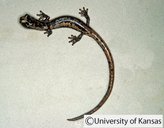|
Bolitoglossa marmorea (Tanner & Brame, 1961)
Subgenus: Eladinea | family: Plethodontidae subfamily: Hemidactyliinae genus: Bolitoglossa |
 © 2010 Division of Herpetology, University of Kansas (1 of 2) |
|
|
|
Description Diagnosis: Bolitoglossa marmorea is a moderately sized salamander (adults range from 128 to 134 mm in total length; males measure 59-66 mm in standard length, while females are 60-72 mm in standard length; the tail is moderately long at 48-56% of total length) with long limbs and large, moderately webbed feet bearing subterminal pads. Maxillary teeth number 48-80; vomerine teeth number 22-38. Limb interval is 0-0.5 costal folds in males, 1.5-2.5 costal folds in females. Usually 13 costal grooves. It is purplish-brown with yellow flecking and small yellow spots. Similar to B. sooyorum morphologically but distinct molecularly (Savage 2002). Distribution and Habitat Country distribution from AmphibiaWeb's database: Costa Rica, Panama
Life History, Abundance, Activity, and Special Behaviors Trends and Threats Possible reasons for amphibian decline General habitat alteration and loss Comments First described by Tanner and Brame (1961). The species name marmorea refers to its marbled color pattern. A Spanish-language species account can be found at the website of Instituto Nacional de Biodiversidad (INBio).
References
Savage, J. M. (2002). The Amphibians and Reptiles of Costa Rica:a herpetofauna between two continents, between two seas. University of Chicago Press, Chicago, Illinois, USA and London. Stuart, S., Hoffmann, M., Chanson, J., Cox, N., Berridge, R., Ramani, P., Young, B. (eds) (2008). Threatened Amphibians of the World. Lynx Edicions, IUCN, and Conservation International, Barcelona, Spain; Gland, Switzerland; and Arlington, Virginia, USA. Tanner, W. W., and Brame, A. H. Jr. (1961). ''Description of a new species of salamander from Panamá.'' Great Basin Naturalist, 21, 23-26. Wake, D. B. (1987). ''Adaptive radiation of salamanders in Middle American cloud forests.'' Annals of the Missouri Botanical Garden, 74(2), 242-264. Wake, D. B., Brame, A. H. and Duellman, W. E. (1973). ''New species of salamanders, genus Bolitoglossa, from Panama.'' Natural History Museum of Los Angeles County - Contributions in Science, 248, 1-19. Originally submitted by: Nelly Chow (first posted 2009-11-02) Edited by: Kellie Whittaker (2011-03-11) Species Account Citation: AmphibiaWeb 2011 Bolitoglossa marmorea <https://amphibiaweb.org/species/3987> University of California, Berkeley, CA, USA. Accessed Mar 29, 2025.
Feedback or comments about this page.
Citation: AmphibiaWeb. 2025. <https://amphibiaweb.org> University of California, Berkeley, CA, USA. Accessed 29 Mar 2025. AmphibiaWeb's policy on data use. |



 Raffaëlli Account
Raffaëlli Account Map of Life
Map of Life